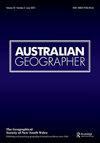吸烟流动的社会公正问题
IF 2
2区 社会学
Q2 GEOGRAPHY
引用次数: 0
摘要
2014年,Hazelwood煤矿大火燃烧了45天。当地社区受到烟雾和灰烬的影响,有报道称一氧化碳水平升高。当地新闻和社交媒体报道称,居民们出现了许多吸入烟雾的身体症状,包括流鼻血、咳嗽、喘息和胸闷。居民可以在室外佩戴过滤颗粒物的纸口罩。灰尘和灰烬不断渗入家庭和办公室,每天都需要清理,有时一天要清理好几次。烟雾可以自由地跨越身体和身体的界限,而那些最脆弱的人却因为缺乏移动而受到阻碍:孕妇、老人和儿童被建议离开该地区。然而,这种“简单”移动的建议忽略了社区在多年经济衰退和社会变革中受到不成比例影响的背景。本文探讨了由于这一事件而产生的烟雾和人员的不平等流动,并借鉴了流动正义(Sheller Citation2018)和紧急流动(Adey Citation2016)的概念,以反思危机时期不平等流动的政治层面。本文章由计算机程序翻译,如有差异,请以英文原文为准。
The social justice issues of smoke im/mobilities
In 2014, the Hazelwood mine fire burned for 45 days. Local communities were impacted by smoke and ash, and there were reports of raised carbon monoxide levels. Local news and social media reported residents experiencing numerous physical symptoms of smoke inhalation, including bleeding noses, coughing, wheezing and chest tightness. Paper masks to filter particulate matter were made available to residents to wear outside. The dust and ash constantly seeped into homes and offices, which required cleaning daily and sometimes multiple times during the day. Smoke was free to move across physical and bodily boundaries while those most vulnerable were hampered by lack of movement: pregnant women, the elderly and children were advised to leave the area. However, this suggestion to ‘simply’ move ignored the context of a community disproportionately impacted through years of economic decline and societal change. This paper explores the unequal mobilities of smoke and people that arose as a result of this event and draws on concepts of mobility justice (Sheller Citation2018) and emergency mobilities (Adey Citation2016) to reflect on the political dimensions of uneven mobility in times of crisis.
求助全文
通过发布文献求助,成功后即可免费获取论文全文。
去求助
来源期刊

Australian Geographer
GEOGRAPHY-
CiteScore
4.10
自引率
8.30%
发文量
33
期刊介绍:
Australian Geographer was founded in 1928 and is the nation"s oldest geographical journal. It is a high standard, refereed general geography journal covering all aspects of the discipline, both human and physical. While papers concerning any aspect of geography are considered for publication, the journal focuses primarily on two areas of research: •Australia and its world region, including developments, issues and policies in Australia, the western Pacific, the Indian Ocean, Asia and Antarctica. •Environmental studies, particularly the biophysical environment and human interaction with it.
 求助内容:
求助内容: 应助结果提醒方式:
应助结果提醒方式:


